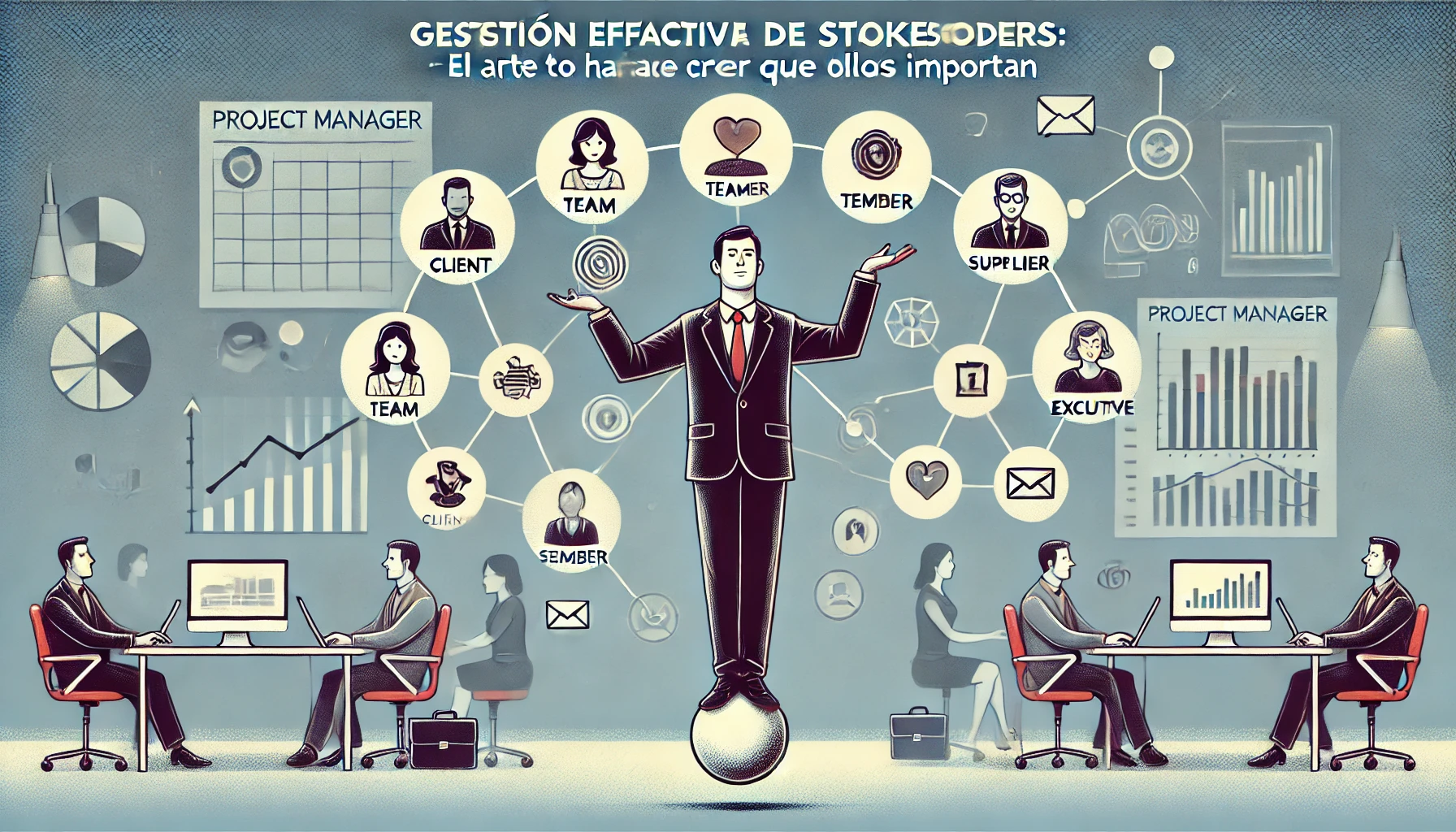
When you work on a project, one of the most critical aspects of ensuring success is stakeholder management. Ensuring that all stakeholders are aligned and collaborate is anything but easy. How do you make everyone believe they matter?
In this article, we will explain what stakeholder management is, how to develop an effective plan, the skills needed to manage them, and best practices for dealing with common challenges. And this is as useful in any environment as it is in any other.
What is Stakeholders management?
The Stakeholder management or Stakeholder management is more than a process: it is the art of knowing, understanding and managing the expectations of the people, groups or organizations that may influence or be affected by a project. It is not just another step, but an essential strategy to minimize risks and gain support. Imagine being in a project meeting and suddenly a key stakeholder expresses that something does not convince him: if you are not prepared, that objection could paralyze everything. That’s why good stakeholder management is crucial.
What is a Stakeholder in project management?
A Stakeholder is any individual or organization with a stake in the project, from the manager who approves budgets to the client who expects the final product. They can be internal, such as team members, or external, such as regulators and suppliers. The key is to remember that not everyone has the same level of power or the same expectations, but everyone needs to be heard in some way.
Development of a Stakeholders management plan
A stakeholder management plan is like a map that guides how you will address their needs and expectations during the project. It’s not just about writing a list, but designing a strategy that helps you stay calm and move forward when the going gets tough.
A good plan for stakeholder management Stakeholders should include:
- IdentificationCreate a list that includes from the most obvious Stakeholders to those that might go unnoticed but could influence the project. Take into account the organization chart (and its type).
- Expectation and influence analysisMake an outline that shows you who has the most power and interest in the project. This will help you know where to focus your efforts.
- Roles and Responsibilities Matrix (RACI Matrix)Clearly define who is responsible for what in stakeholder management. This is done through a RACI (Responsible, Accountable, Consulted, Informed) matrix, visualizing who should be informed of what, consulted, etc.
- Communication strategiesDecide how you will keep each stakeholder informed and engaged. For example, a customer might prefer weekly meetings, while a supplier will only need a monthly report. So, how will you communicate in stakeholder management?
How to create an effective stakeholder management plan
Creating an effective stakeholder management plan is not a bureaucratic red tape, it’s a lifesaver. Here’s why and how:
- Alignment of expectationsNo more unpleasant surprises in the middle of the project. Ensures that all stakeholders understand the project objectives and know what to expect at each stage.
- Risk reductionRisk reduction: Identifying and addressing stakeholder concerns from the outset helps to avoid surprises and conflicts that could delay the project.
- Improving communicationA stakeholder management plan establishes how and when key information will be communicated, avoiding misunderstandings and improving trust between all parties.
- Facilitates decision makingKnowing who is responsible and who should be consulted in each decision saves time and speeds up the process.
To create an effective plan, follow these steps:
- Stakeholder identification and analysis Start by identifying all stakeholders involved in the project, both internal and external. Conduct a power/interest analysis to classify them according to their level of influence and their degree of interest in the project. This classification will help you prioritize management and communication efforts.
Don’t just stick with the initial list. Ask your team and review similar projects to identify all potential stakeholders. Then, rank them according to their power and interest in a matrix. - Establishment of objectives and expectations Document what each stakeholder expects from the project and define the key objectives you need to meet to satisfy those expectations. This will allow you to better manage demands and anticipate possible conflicts or changes in the project approach.
- Development of customized communication strategies Not all stakeholders need the same level of information and involvement. Define specific communication strategies for each stakeholder group, determining the frequency, the communication channel (e.g. face-to-face meetings, emails, updates on collaborative platforms) and the level of detail they will receive.
- Implementation of the RACI matrix Use the RACI matrix to clarify responsibilities in stakeholder management. This will help you know who is responsible (Responsible), who has final authority (Accountable), who should be consulted (Consulted) and who should be informed (Informed). This matrix is essential to avoid confusion and ensure that everyone knows their role in the process.
Ah! A stakeholder management plan is not static; you must review and adjust it throughout the project. Use periodic review meetings and solicit feedback from stakeholders to adapt strategies to new circumstances or expectations. This ensures that the plan remains relevant and effective.
Skills needed for effective stakeholder management
The stakeholder management is an art, and soft and hard skills are required to achieve a solid and stable relationship with them. Communicating clearly and negotiating effectively are the basis for problem-solving management and creating an environment of collaboration and trust.
Strategies for managing relationships with stakeholders
Strategies for effective stakeholder management focus not only on communication, but on deeply understanding their needs and creating a collaborative environment. Here are some of the most effective strategies:
- Establishes proactive communicationDon’t wait for problems to arise before communicating. Proactive communication involves keeping stakeholders informed from the beginning, sharing relevant updates and anticipating potential concerns. For example, holding regular update meetings (weekly or monthly) ensures that stakeholders feel involved and aligned with project objectives.
- Active listening and empathyOne of the most underestimated strategies is to practice active listening. This involves not only hearing what stakeholders say, but understanding their concerns and perspectives. Empathy plays an important role here: demonstrating that you understand their views and that their opinions matter helps build trusting relationships.
- Customize interactionNot all stakeholders have the same expectations and level of interest in the project. Customize the way you interact with each stakeholder, tailoring your message and level of detail according to their role and influence. For example, a key customer may need detailed reports and frequent meetings, while an internal support team may require more general and spaced out updates.
- Manage expectations realisticallyBe honest about what is and is not possible helps to avoid disappointment and maintain credibility. Don’t promise results you can’t deliver. Instead, set realistic expectations from the outset and keep stakeholders informed of any changes in timelines or deliverables. This transparency strengthens the relationship and fosters better collaboration.
- Solicits and acts on feedbackFeedback is key to improving stakeholder management. Solicit feedback regularly and demonstrate that you act on it. Stakeholders value when their opinions are taken into account and they see changes in the project reflected. This not only increases participation, but also reduces resistance to future decisions.
- Promotes a collaborative environmentMake stakeholders feel part of the project by inviting them to participate in brainstorming sessions or planning workshops. When they feel valued and see that their ideas are implemented, they become more committed allies and willing to support the team at critical moments.
- Uses relationship management toolsDigital tools, such as customer relationship management (CRM) systems, can make it easier to track stakeholder interactions, preferences and needs. This helps to further personalize communication and keep track of conversations and agreements, avoiding misunderstandings and improving long-term management.
Challenges and solutions in stakeholder management
The Stakeholder management can be complex, as it involves balancing different interests, levels of influence and expectations. Addressing common challenges proactively and with clear strategies is essential to ensure that the project continues to move forward smoothly.
How a project manager should involve stakeholders
An effective project manager must involve stakeholders from the very beginning of the project and ensure that their participation continues throughout the process. Here’s how to do it:
- Involves from the beginningStakeholder early involvement is crucial. By including them in the early stages of project planning and definition, their expectations and input can be gathered, which contributes to a more comprehensive approach aligned with their interests.
- Maintain clear and constant communicationCommunication should not be limited to status updates. It is critical to maintain an open and transparent dialogue. Scheduling regular points of contact, such as periodic meetings, reports and briefings, ensures that everyone is aware of progress and possible changes in the project.
- Facilitates shared decision makingInvolving stakeholders in key decisions makes them active participants and not just observers. This may include participation in planning workshops, brainstorming sessions or review meetings where their opinions are valued and their recommendations are taken into account.
- Adapt your approach according to the stakeholderNot all stakeholders have the same level of influence or interest. Adjusting your engagement strategy according to their roles and needs ensures that each gets the right attention and information. Using a power/interest matrix helps you segment stakeholders and decide how to approach each group.
- Use digital support tools and online channels: Surely there is a Teams or other tool that allows you to communicate continuously with stakeholders. This will also give you an additional point of transparency. Show them that their contributions are taken into account, the progress and above all, if you discard something, explain the reason why.
Collaborative platforms and project management systems, such as Jira o Trellocan facilitate communication and keep stakeholders informed. These tools allow you to share updates, collect feedback and track progress in real time.
Solutions to common problems in stakeholder management
What do I do if my Stakeholders go off the rails and my management goes down the drain? Here are the most common problems and how to deal with them effectively:
- Lack of stakeholder participationOne of the most critical problems is the lack of stakeholder engagement. This can manifest itself in lack of attendance at meetings, lack of feedback or general passivity. The situation becomes more complicated when these stakeholders have the power to influence or stop the project. Possible solutionEstablish a personalized communication plan that includes regular updates and one-on-one meetings to maintain their interest. Use the RACI matrix to identify whether that stakeholder is really key. If they are, a one-on-one meeting to explain the negative impact of their lack of participation can be an important step to redirect the situation and ensure their collaboration.
- Unrealistic expectationsOften, stakeholders may have unreasonable expectations that do not align with the available resources or the scope of the project. Wanting to meet all demands instantly can lead to team burnout and project failure. Possible solutionSet realistic expectations from the start and maintain transparency at every stage of the project. Avoid the urge to say “yes” to everything and explain clearly what is possible and what is not. Present alternatives, such as including certain features in future phases, to maintain stakeholder satisfaction without compromising the project’s viability.
- Conflicts between stakeholdersStakeholders may have conflicting interests and priorities, which can create tensions and affect the project. It is essential to mediate impartially to find a balance and maintain progress. Possible solutionNegotiation: uses negotiation techniques to facilitate discussions in which all opinions are heard and common ground is sought. Convenes specific meetings to resolve conflicts and employs the RACI matrix matrix to clarify the responsibilities and roles of each stakeholder, reducing ambiguity and favoring balanced decision making.
- Constantly shifting prioritiesChanges in priorities are inevitable in any project, but when they become constant and destabilize the team, they can harm productivity and progress.Possible solutionImplement a change management change management structured that all stakeholders understand and respect. It clearly explains the implications of changes in terms of timing and resources, and establishes criteria for accepting or rejecting changes based on their impact and urgency. A well-defined change policy helps maintain stability and avoids unnecessary disruptions.
Conclusion
Stakeholder management is an essential component to the success of any project. Developing a detailed plan, maintaining constant communication and using appropriate tools are key steps to ensure that all stakeholders are aligned with the project objectives.
Following these practices will allow you to minimize risk and maximize stakeholder support and acceptance.



